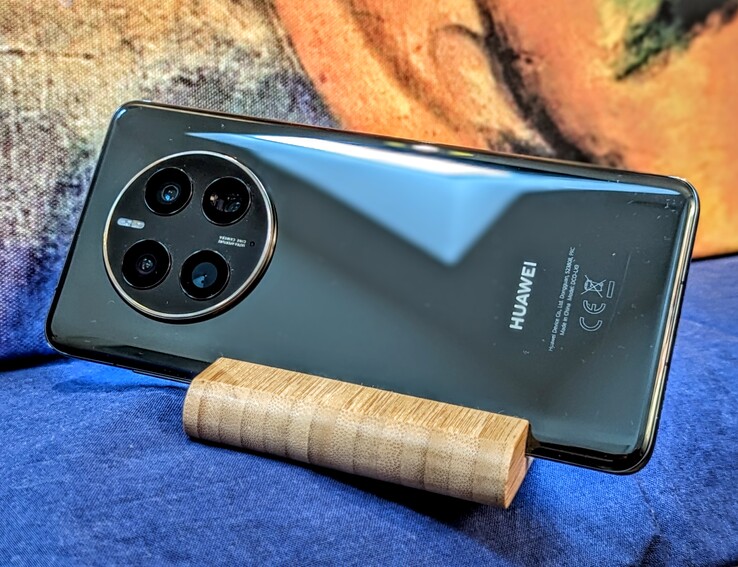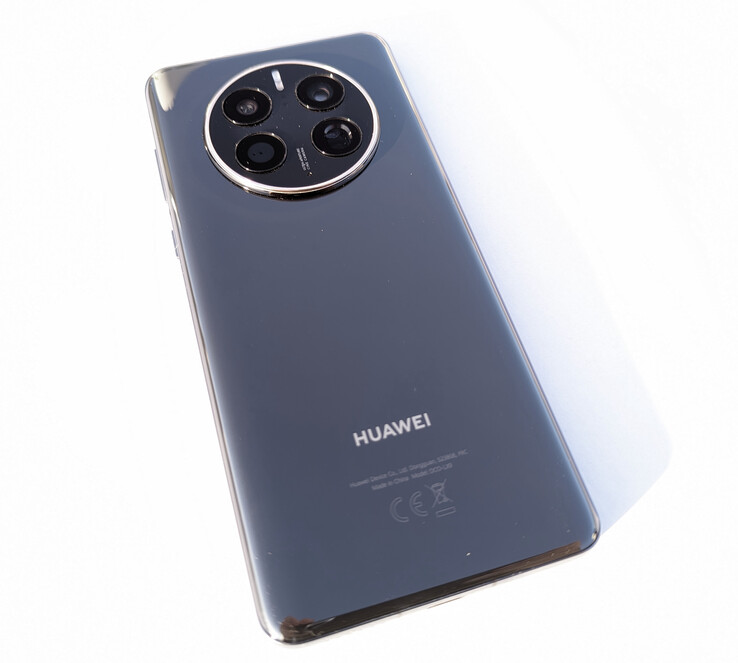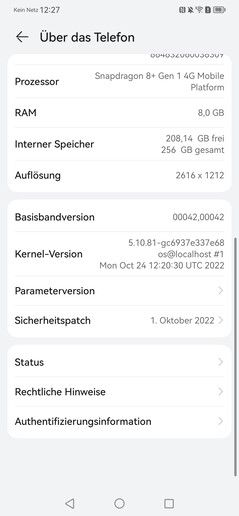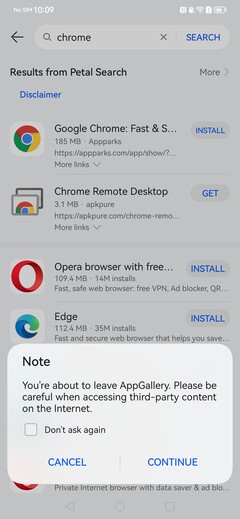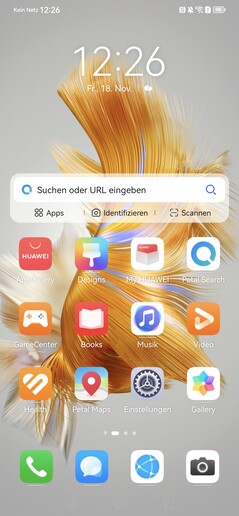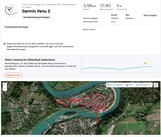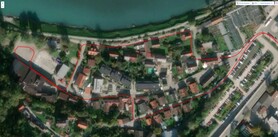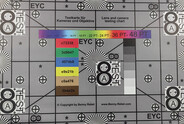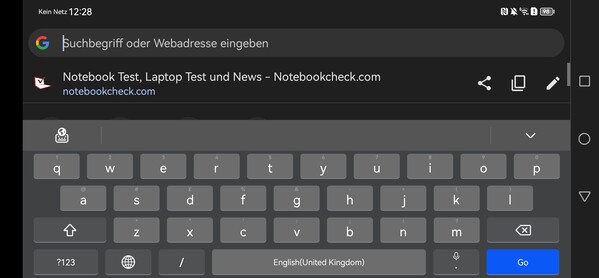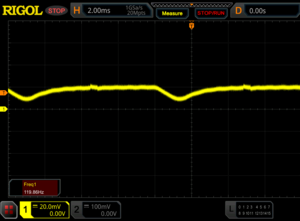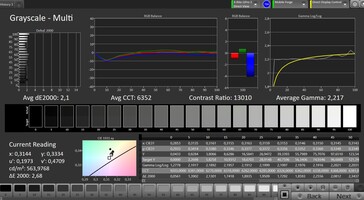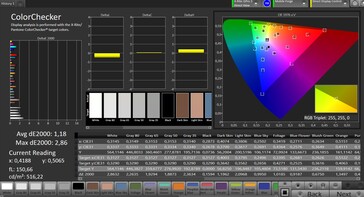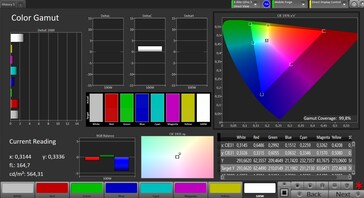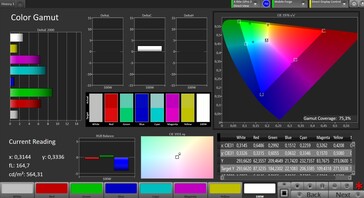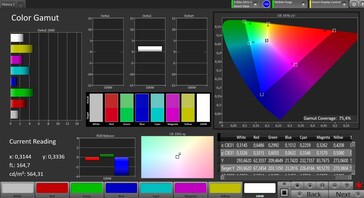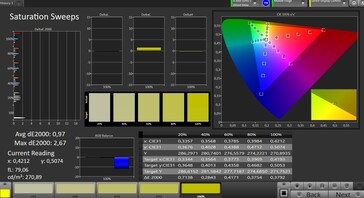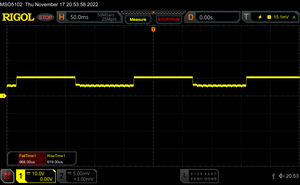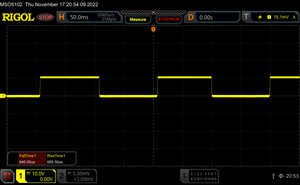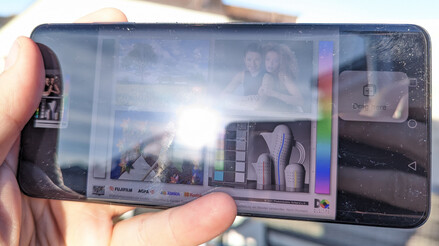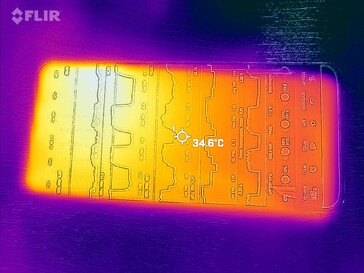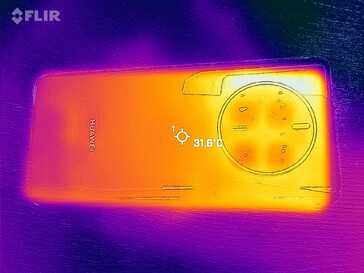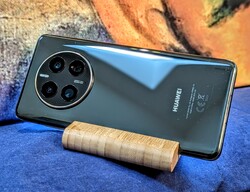Huawei Mate 50 Pro smartphone review: The camera star has problems
Huawei has been delivering fantastic camera smartphones for years. However, the Chinese manufacturer has also been cut off from Google's services for years and is trying to build its own ecosystem with Huawei Mobile Services. In fact, many manufacturers are porting their apps to the platform, but certain tricks are often necessary to get the apps running. Especially when it comes to popular apps from Google, it sometimes doesn't work at all.
Of course, these are not the best prerequisites for Huawei's Mate 50 Pro, which is on offer for around US$ 1200 - not exactly cheap. But Huawei claims to offer a lot in return: an innovative camera with a variable aperture for natural bokeh effects, a high-quality optical zoom, as well as good equipment and material quality outside the camera. In addition, the company has abandoned its Kirin chips and now uses a Qualcomm SoC.
So, what predominates: frustration about the limited software, or joy about the high-quality phone? Find out in the following review.
Possible Competitors in Comparison
Rating | Date | Model | Weight | Drive | Size | Resolution | Price |
|---|---|---|---|---|---|---|---|
| 88.9 % v7 (old) | 11 / 2022 | Huawei Mate 50 Pro SD 8+ Gen 1, Adreno 730 | 209 g | 256 GB UFS 3.1 Flash | 6.70" | 2616x1212 | |
| 90.6 % v7 (old) | 11 / 2020 | Huawei Mate 40 Pro Kirin 9000, Mali-G78 MP24 | 212 g | 256 GB UFS 3.1 Flash | 6.76" | 2772x1344 | |
| 89.4 % v7 (old) | 03 / 2022 | Samsung Galaxy S22 Ultra 5G Exynos 2200, Xclipse 920 | 228 g | 128 GB UFS 3.1 Flash | 6.80" | 3088x1440 | |
| 90.3 % v7 (old) | 03 / 2023 | Apple iPhone 14 Pro Max A16, A16 GPU 5-Core | 240 g | 128 GB NVMe | 6.70" | 2796x1290 | |
| 89.2 % v7 (old) | 06 / 2021 | Xiaomi Mi 11 Ultra SD 888 5G, Adreno 660 | 234 g | 256 GB UFS 3.1 Flash | 6.81" | 3200x1440 | |
| 87 % v7 (old) | 08 / 2022 | OnePlus 10T SD 8+ Gen 1, Adreno 730 | 203.5 g | 256 GB UFS 3.1 Flash | 6.70" | 2412x1080 |
Case - Premium chassis with glass and aluminum
Huawei really cannot be accused of skimping on the case: High-quality metal and glass are used in the Mate 50 Pro and all elements merge seamlessly. The smartphone is IP68 certified, namely dust- and water-proof, and withstands both pressure and twisting.
With its glossy glass back in black or silver and the large, round camera module in the upper area, Huawei's Mate 50 Pro not only looks chic, but also feels good and balanced when held and does not wobble on the table. However, the phone is very susceptible to fingerprints, so frequent cleaning is necessary to maintain its high-quality look.
The screen and back are protected by Huawei's Kunlun Glass, which is said to be particularly resistant to fall damage.
Equipment - Own memory card format
Only one configuration variant of the Huawei Mate 50 Pro is offered in Europe: For 8 GB of RAM and 256 GB of mass storage, Huawei is asking EUR 1,199. A version with 512 GB of storage is also available in other countries.
At least Huawei endows the USB-C port with slightly faster transfer speed, namely USB-C 3.1 Gen.1 with up to 5 GBit/s. A DisplayPort signal can also be output via the USB-C port so that the smartphone can be connected directly to a monitor.
You can also look forward to an infrared port again, which can be used to control TVs directly with the smartphone. NFC for mobile payment services is on board, but Google Pay cannot be used due to the missing services. Huawei is promoting its own alternative, Huawei Pay, but this does not work in Germany and Austria via NFC, but via barcodes from the provider Bluecode, which are only accepted at selected retailers.
Instead of a microSD card, only Huawei's own NM card format is supported. While they are as compact as a nano-SIM, there are currently only a few providers and the cards are available up to a maximum of 256 GB. You can also insert two SIM cards in the SIM tray instead.
Software - App limitations
Huawei's software is based on the open-source part of Android, so long-time users of Google's operating system do not have to undergo a complete readjustment. However, as previously mentioned, Google Services is missing, which, for example, links the smartphone's location function with apps or provides registration options, so Android apps have to be adapted by the developers accordingly in order to work with Huawei's services.
As a result, not all apps can be used on the Huawei Mate 50 Pro; Google's apps in particular usually do not work. The Chrome browser starts working, but soon complains about missing components. Many things appear to be improvised and this may put off inexperienced users, such as when Huawei's App Gallery warns us during installation that we are downloading an app from a potentially unsafe third-party provider.
If you buy a device that requests to be linked via a manufacturer's app, you should check in advance whether it is also compatible with the smartphone. Even though Huawei states that 90% of the most popular apps out there can be used, its own alternatives such as Petal Maps usually work well, and the App Gallery is constantly improving. Of course, it is annoying when the one app that you need is missing.
Huawei pre-installs many ad apps and games or offers the possibility to download them via icons on the home screen. So you have to do a little tidying up if you want a clean system.
In its first month in Europe, the device received two updates. The security patches were from the beginning of October 2022 at the time of review and thus quite up-to-date. The manufacturer promises at least two OS updates and three years of security patches, which is generally standard.
DRM L1 is available so that streaming content can be enjoyed in full quality.
Communication & GNSS - Only 4G in the flagship phone
Somewhat annoying is the fact that Huawei's Mate 50 Pro does not support WiFi 6E: Although there are still very few routers that support the fastest WLAN standard currently available, it can bring significant speed advantages, as our tests show.
So you have to be content with WiFi 6. While this is not enough for top position in terms of WLAN speed, the Mate 50 Pro nonetheless achieves very solid rates of around 950 MBit/s under testing in conjunction with our Asus ROG Rapture AXE11000 reference router.
Due to US trade restrictions against Huawei, the Mate 50 Pro is only a 4G phone, which is a considerable shortcoming for a flagship phone in 2022. At least the smartphone covers all the necessary frequencies for functionality on the 4G network worldwide and delivers very good signal strength in our tests.
In China, Huawei's Mate series offers a feature that Apple also introduced for its latest generation of devices: If no cell phone network is available, but an emergency call has to be made, the smartphone can fall back on the Beidou satellite network. This means that communication is also possible in remote areas.
| Networking | |
| iperf3 receive AXE11000 | |
| OnePlus 10T | |
| Huawei Mate 50 Pro | |
| Average of class Smartphone (52 - 1857, n=180, last 2 years) | |
| Apple iPhone 14 Pro Max | |
| Samsung Galaxy S22 Ultra 5G | |
| iperf3 transmit AXE11000 | |
| Huawei Mate 50 Pro | |
| OnePlus 10T | |
| Apple iPhone 14 Pro Max | |
| Average of class Smartphone (49.8 - 1828, n=180, last 2 years) | |
| Samsung Galaxy S22 Ultra 5G | |
| iperf3 transmit AXE11000 6GHz | |
| Samsung Galaxy S22 Ultra 5G | |
| Average of class Smartphone (508 - 1945, n=96, last 2 years) | |
| iperf3 receive AXE11000 6GHz | |
| Samsung Galaxy S22 Ultra 5G | |
| Average of class Smartphone (451 - 1870, n=96, last 2 years) | |
| iperf3 transmit AX12 | |
| Huawei Mate 40 Pro | |
| Xiaomi Mi 11 Ultra | |
| iperf3 receive AX12 | |
| Huawei Mate 40 Pro | |
| Xiaomi Mi 11 Ultra | |
Huawei supports a variety of networks for the smartphone's satellite positioning, namely GPS, AGS, GLONASS, BeiDou, Galileo, QZSS, and NavIC. Localiaztion outdoors takes place very quickly and precisely at an accuracy of up to 3 meters.
The smartphone passes our practical test, a bike ride with the Garmin Venu 2 as a comparison device, with flying colors: Apart from a small deviation at the end of the ride, the Mate 50 Pro's tracking capability is very precise.
Telephony & Voice Quality - Clearly understandable
Huawei's standard telephony and contact apps are preinstalled on the device. We were also able to download Google's standard apps via apk download and use them without problems, even though they complained that the device was not supported.
The voice quality of the smartphone is very good. The earpiece can get very loud, which is why nearby parties may hear what our conversation partner is saying. The speaker's voice is also transmitted clearly, both when we make calls on the device and when we speak hands-free. However, one should not speak too softly, otherwise the microphone may fail to pick up our voice.
Cameras - Sharpness, zoom and bokeh are impressive
Huawei has discontinued its long-standing cooperation with Leica and is now launching the Huawei Mate 50 Pro without the famous brand name. The camera setup on the back has been completely revised, compared to the predecessor Huawei Mate 40 Pro.
This consists of a 50-megapixel main camera with a variable aperture and an optical image stabilizer. Images are usually taken at 12.5 megapixels in order to achieve even higher light output, but it is also possible to use the full resolution.
The camera takes very nice pictures where the main subject is clearly displayed and the background is slightly blurred. In ambient pictures, a lot of details are visible and, despite the cloudy weather, color reproduction is still decent. Even in candlelight, the Huawei Mate 50 Pro still takes good photos with lots of details and well-lit areas, whereas the Honor Magic4 Pro shows slightly more dynamics here.
A real optical zoom is possible with the help of the periscope camera. The image processor renders the final image from simultaneous pictures of the main camera and the zoom lens, so the pictures are quite sharp even at longer distances.
Videos can be recorded in 4K resolution and at 60 FPS. However, given the price range, there is no option to record movies in 8K. Nevertheless, Huawei's Mate 50 Pro produces moving images in very good quality. A hybrid zoom between the ultra-wide-angle and the main camera is also possible during recording.
At the front, there is a 13-MP selfie camera. It displays faces very clearly, but could do with a little more dynamics in dark areas.
Image comparison
Choose a scene and navigate within the first image. One click changes the position on touchscreens. One click on the zoomed-in image opens the original in a new window. The first image shows the scaled photograph of the test device.
Main camera - flowerMain camera - environmentMain camera - low lightWide angle cameraAs a special innovation, the Huawei Mate 50 Pro integrates a physically existing variable aperture into the main camera, which is intended to ensure soft and precise blurring effects in the background.
We compared the bokeh effect with other strong camera smartphones and found that the Mate 50 Pro actually does a very good job: The focused poinsettia is displayed very sharply, while the background with its not-excessive blur makes the plant stand out very well. Thanks to the variable aperture, the strength of the bokeh effect can even be regulated.
The Honor Magic4 Pro also does a good job, while the digitally generated bokeh of the Google Pixel 7 Pro appears overdone and is not quite accurate either.
The Mate 50 Pro also takes very sharp photos under laboratory conditions and lights up subjects very well at only 1 lux.
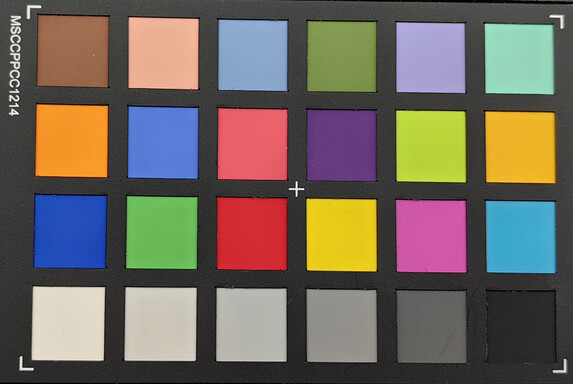
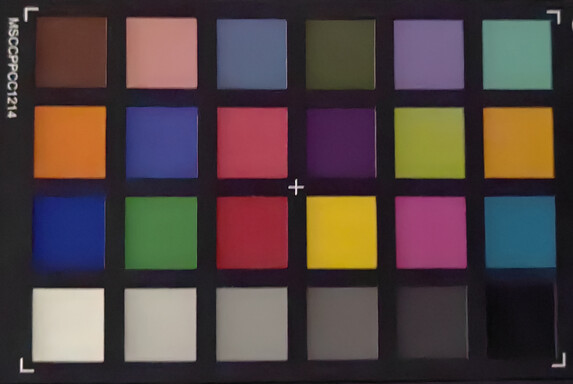
Accessories & Warranty - Hardly any official accessories to buy
Huawei packs a decent package of accessories in the smartphone's box: a 66-watt charger, a USB cable, a silicone bumper, and a SIM tool are included. A protective film is attached to the display ex-works.
Huawei offers a 24-month warranty for its phone in Germany. This may differ in other countries, so be sure to check with your supplier before purchasing.
Input Devices & Operation - Accurate facial recognition
The touchscreen, with its glass curved over the corners, allows for very precise input and is very reactive thanks to the 120 Hz panel and 300 touch queries per second. Even fingers lying on the edge do not interfere with operation.
A fingerprint sensor under the display's glass is available for authentication. It recognizes previously registered fingers very accurately and unlocks the phone almost immediately.
Huawei is following Apple's example and has installed an infrared sensor on the front, which is used for facial recognition and creates a 3D image together with the front camera so that the technology is less susceptible to tricking. The facial recognition also works quickly and reliably in the dark.
Display – Huawei with very bright AMOLED
At 2,616 x 1,212 pixels, the AMOLED screen in the Mate 50 Pro offers slightly fewer pixels than other phones in this price range. On the other hand, the difference is not visible to the naked eye, and content is still displayed very sharply.
In our test with the spectrophotometer, we measured an average brightness of 944.8 cd/m². A good value, but it cannot quite keep up with the top values of the Galaxy S22 Ultra or the iPhone 14 Pro Max. Nevertheless, it is sufficient for HDR playback.
| |||||||||||||||||||||||||
Brightness Distribution: 92 %
Center on Battery: 940 cd/m²
Contrast: ∞:1 (Black: 0 cd/m²)
ΔE ColorChecker Calman: 1.18 | ∀{0.5-29.43 Ø4.78}
ΔE Greyscale Calman: 2.1 | ∀{0.09-98 Ø5}
99.8% sRGB (Calman 2D)
Gamma: 2.217
CCT: 6352 K
| Huawei Mate 50 Pro AMOLED, 2616x1212, 6.7" | Huawei Mate 40 Pro OLED, 2772x1344, 6.8" | Samsung Galaxy S22 Ultra 5G Dynamic AMOLED, 3088x1440, 6.8" | Apple iPhone 14 Pro Max Super Retina XDR OLED, 2796x1290, 6.7" | Xiaomi Mi 11 Ultra AMOLED, 3200x1440, 6.8" | OnePlus 10T Fluid AMOLED, 2412x1080, 6.7" | |
|---|---|---|---|---|---|---|
| Screen | -15% | 17% | 7% | -9% | -31% | |
| Brightness middle (cd/m²) | 940 | 778 -17% | 1077 15% | 1061 13% | 891 -5% | 861 -8% |
| Brightness (cd/m²) | 945 | 782 -17% | 1093 16% | 1057 12% | 888 -6% | 856 -9% |
| Brightness Distribution (%) | 92 | 95 3% | 97 5% | 99 8% | 99 8% | 97 5% |
| Black Level * (cd/m²) | ||||||
| Colorchecker dE 2000 * | 1.18 | 1.4 -19% | 1.2 -2% | 1.3 -10% | 1.9 -61% | 2.27 -92% |
| Colorchecker dE 2000 max. * | 2.86 | 3.5 -22% | 2 30% | 3.1 -8% | 3.7 -29% | 4.17 -46% |
| Greyscale dE 2000 * | 2.1 | 2.5 -19% | 1.3 38% | 1.6 24% | 1.3 38% | 2.9 -38% |
| Gamma | 2.217 99% | 2.22 99% | 2.37 93% | 2.19 100% | 2.3 96% | 2.303 96% |
| CCT | 6352 102% | 6530 100% | 6526 100% | 6511 100% | 6527 100% | 6141 106% |
* ... smaller is better
Screen Flickering / PWM (Pulse-Width Modulation)
| Screen flickering / PWM detected | 119.9 Hz | ||
The display backlight flickers at 119.9 Hz (worst case, e.g., utilizing PWM) . The frequency of 119.9 Hz is very low, so the flickering may cause eyestrain and headaches after extended use. In comparison: 53 % of all tested devices do not use PWM to dim the display. If PWM was detected, an average of 8118 (minimum: 5 - maximum: 343500) Hz was measured. | |||
Series of measurements at a fixed zoom level and different brightness settings
Huawei spares the eyes of its users: Even at the lowest brightness setting, only the frame rate of 120 Hz was visible in our test with the oscilloscope, but no PWM signal. The screen's response times are very short, so gamers will be pleased.
Color reproduction was very accurate in our tests, so no differences in color tones are visible to the naked eye.
Display Response Times
| ↔ Response Time Black to White | ||
|---|---|---|
| 1.6 ms ... rise ↗ and fall ↘ combined | ↗ 1 ms rise | |
| ↘ 0.6 ms fall | ||
| The screen shows very fast response rates in our tests and should be very well suited for fast-paced gaming. In comparison, all tested devices range from 0.1 (minimum) to 240 (maximum) ms. » 8 % of all devices are better. This means that the measured response time is better than the average of all tested devices (20.2 ms). | ||
| ↔ Response Time 50% Grey to 80% Grey | ||
| 1.3 ms ... rise ↗ and fall ↘ combined | ↗ 0.6 ms rise | |
| ↘ 0.7 ms fall | ||
| The screen shows very fast response rates in our tests and should be very well suited for fast-paced gaming. In comparison, all tested devices range from 0.165 (minimum) to 636 (maximum) ms. » 5 % of all devices are better. This means that the measured response time is better than the average of all tested devices (31.6 ms). | ||
Performance - Now with Qualcomm SoC
Huawei has a small surprise in store for the SoC of the Mate 50 Pro: The smartphone does not use the in-house Kirin processor, the production of which Huawei had to stop due to trade restrictions. Instead, Huawei now uses a Qualcomm Snapdragon 8+ Gen 1, which is one of the most powerful SoCs currently on the market.
The Huawei Mate 50 Pro cannot quite keep up with the new iPhones, but it does take first place in the benchmarks among the competing Android devices. In everyday use, this is enough for smooth operation, even in very performance-intensive apps.
| UL Procyon AI Inference for Android - Overall Score NNAPI | |
| Average Qualcomm Snapdragon 8+ Gen 1 (3291 - 84787, n=21) | |
| Average of class Smartphone (3769 - 81594, n=137, last 2 years) | |
| Huawei Mate 40 Pro | |
| OnePlus 10T | |
| Samsung Galaxy S22 Ultra 5G | |
| Huawei Mate 50 Pro | |
| AImark - Score v2.x | |
| Xiaomi Mi 11 Ultra | |
| Apple iPhone 14 Pro Max | |
| OnePlus 10T | |
| Average Qualcomm Snapdragon 8+ Gen 1 (1043 - 7865, n=11) | |
| Samsung Galaxy S22 Ultra 5G | |
| Huawei Mate 50 Pro | |
In terms of graphics performance, the Mate 50 Pro can also keep up with the fastest devices on the market, so it is also well equipped for connecting a monitor and graphically demanding apps. Interestingly, onscreen frame rates of over 60 fps are also achieved in simpler benchmarks, but the smartphone locks at 60 fps in more complex tests.
GFXBench (DX / GLBenchmark) 2.7: T-Rex Onscreen | 1920x1080 T-Rex Offscreen
GFXBench 3.0: on screen Manhattan Onscreen OGL | 1920x1080 1080p Manhattan Offscreen
GFXBench 3.1: on screen Manhattan ES 3.1 Onscreen | 1920x1080 Manhattan ES 3.1 Offscreen
GFXBench: on screen Car Chase Onscreen | 1920x1080 Car Chase Offscreen | on screen Aztec Ruins High Tier Onscreen | 2560x1440 Aztec Ruins High Tier Offscreen | on screen Aztec Ruins Normal Tier Onscreen | 1920x1080 Aztec Ruins Normal Tier Offscreen
| 3DMark / Wild Life Extreme Unlimited | |
| Apple iPhone 14 Pro Max | |
| OnePlus 10T | |
| Huawei Mate 50 Pro | |
| Samsung Galaxy S22 Ultra 5G | |
| Xiaomi Mi 11 Ultra | |
| 3DMark / Wild Life Extreme | |
| Apple iPhone 14 Pro Max | |
| OnePlus 10T | |
| Huawei Mate 50 Pro | |
| Samsung Galaxy S22 Ultra 5G | |
| Xiaomi Mi 11 Ultra | |
| 3DMark / Wild Life Unlimited Score | |
| Apple iPhone 14 Pro Max | |
| Huawei Mate 50 Pro | |
| OnePlus 10T | |
| Samsung Galaxy S22 Ultra 5G | |
| Huawei Mate 40 Pro | |
| Xiaomi Mi 11 Ultra | |
| GFXBench (DX / GLBenchmark) 2.7 / T-Rex Onscreen | |
| Xiaomi Mi 11 Ultra | |
| Samsung Galaxy S22 Ultra 5G | |
| OnePlus 10T | |
| Apple iPhone 14 Pro Max | |
| Huawei Mate 50 Pro | |
| GFXBench (DX / GLBenchmark) 2.7 / T-Rex Offscreen | |
| Apple iPhone 14 Pro Max | |
| Huawei Mate 50 Pro | |
| OnePlus 10T | |
| Samsung Galaxy S22 Ultra 5G | |
| Xiaomi Mi 11 Ultra | |
| GFXBench 3.0 / Manhattan Onscreen OGL | |
| Samsung Galaxy S22 Ultra 5G | |
| Xiaomi Mi 11 Ultra | |
| OnePlus 10T | |
| Apple iPhone 14 Pro Max | |
| Huawei Mate 50 Pro | |
| GFXBench 3.0 / 1080p Manhattan Offscreen | |
| Apple iPhone 14 Pro Max | |
| Huawei Mate 50 Pro | |
| OnePlus 10T | |
| Samsung Galaxy S22 Ultra 5G | |
| Xiaomi Mi 11 Ultra | |
| GFXBench 3.1 / Manhattan ES 3.1 Onscreen | |
| Samsung Galaxy S22 Ultra 5G | |
| Xiaomi Mi 11 Ultra | |
| OnePlus 10T | |
| Apple iPhone 14 Pro Max | |
| Huawei Mate 50 Pro | |
| GFXBench 3.1 / Manhattan ES 3.1 Offscreen | |
| Apple iPhone 14 Pro Max | |
| Huawei Mate 50 Pro | |
| OnePlus 10T | |
| Samsung Galaxy S22 Ultra 5G | |
| Xiaomi Mi 11 Ultra | |
| GFXBench / Car Chase Onscreen | |
| OnePlus 10T | |
| Apple iPhone 14 Pro Max | |
| Huawei Mate 50 Pro | |
| Samsung Galaxy S22 Ultra 5G | |
| Xiaomi Mi 11 Ultra | |
| GFXBench / Car Chase Offscreen | |
| OnePlus 10T | |
| Huawei Mate 50 Pro | |
| Apple iPhone 14 Pro Max | |
| Xiaomi Mi 11 Ultra | |
| Samsung Galaxy S22 Ultra 5G | |
| GFXBench / Aztec Ruins High Tier Onscreen | |
| OnePlus 10T | |
| Apple iPhone 14 Pro Max | |
| Huawei Mate 50 Pro | |
| Samsung Galaxy S22 Ultra 5G | |
| Xiaomi Mi 11 Ultra | |
| GFXBench / Aztec Ruins High Tier Offscreen | |
| Huawei Mate 50 Pro | |
| OnePlus 10T | |
| Apple iPhone 14 Pro Max | |
| Xiaomi Mi 11 Ultra | |
| Samsung Galaxy S22 Ultra 5G | |
| GFXBench / Aztec Ruins Normal Tier Onscreen | |
| Huawei Mate 50 Pro | |
| OnePlus 10T | |
| Apple iPhone 14 Pro Max | |
| Xiaomi Mi 11 Ultra | |
| Samsung Galaxy S22 Ultra 5G | |
| GFXBench / Aztec Ruins Normal Tier Offscreen | |
| Apple iPhone 14 Pro Max | |
| OnePlus 10T | |
| Huawei Mate 50 Pro | |
| Xiaomi Mi 11 Ultra | |
| Samsung Galaxy S22 Ultra 5G | |
The Mate 50 Pro fails in the browser benchmarks and is even slower than the predecessor in some cases. This is also noticeable during web browsing: Although pages load relatively quickly, other smartphones display images immediately when scrolling, but you have to wait longer on Huawei's smartphone.
| Jetstream 2 - 2.0 Total Score | |
| Apple iPhone 14 Pro Max (Safari 16) | |
| Average of class Smartphone (23.8 - 387, n=153, last 2 years) | |
| Average Qualcomm Snapdragon 8+ Gen 1 (76.2 - 204, n=23) | |
| Samsung Galaxy S22 Ultra 5G (Chrome 99) | |
| Xiaomi Mi 11 Ultra (Chrome91) | |
| OnePlus 10T (Chrome 104) | |
| Huawei Mate 40 Pro (Huawei Browser 11) | |
| Huawei Mate 50 Pro (Chrome 107) | |
| Speedometer 2.0 - Result 2.0 | |
| Apple iPhone 14 Pro Max (Safari 16) | |
| Average of class Smartphone (15.2 - 643, n=128, last 2 years) | |
| Average Qualcomm Snapdragon 8+ Gen 1 (69.1 - 196, n=18) | |
| Samsung Galaxy S22 Ultra 5G (Chrome 99) | |
| Xiaomi Mi 11 Ultra (Chrome91) | |
| OnePlus 10T (Chrome 104) | |
| Huawei Mate 40 Pro (Huawei Browser 11) | |
| Huawei Mate 50 Pro (Chome 107) | |
| WebXPRT 4 - Overall | |
| Apple iPhone 14 Pro Max (Safari 16) | |
| Average of class Smartphone (27 - 306, n=147, last 2 years) | |
| Average Qualcomm Snapdragon 8+ Gen 1 (69 - 159, n=21) | |
| OnePlus 10T | |
| Huawei Mate 50 Pro (Chrome 107) | |
| WebXPRT 3 - Overall | |
| Apple iPhone 14 Pro Max (Safari 16) | |
| Average of class Smartphone (38 - 380, n=35, last 2 years) | |
| Average Qualcomm Snapdragon 8+ Gen 1 (106 - 224, n=14) | |
| Huawei Mate 40 Pro (Huawei Browser 11) | |
| Xiaomi Mi 11 Ultra (Chrome91) | |
| Samsung Galaxy S22 Ultra 5G (Chrome 99) | |
| Huawei Mate 50 Pro (Chrome 107) | |
| OnePlus 10T (Chrome 104) | |
| Octane V2 - Total Score | |
| Apple iPhone 14 Pro Max (Safari 16) | |
| Average of class Smartphone (2228 - 121337, n=200, last 2 years) | |
| Average Qualcomm Snapdragon 8+ Gen 1 (17622 - 61536, n=24) | |
| OnePlus 10T (Chrome 104) | |
| Samsung Galaxy S22 Ultra 5G (Chrome 99) | |
| Xiaomi Mi 11 Ultra (Chrome91) | |
| Huawei Mate 40 Pro (Huawei Browser 11) | |
| Huawei Mate 50 Pro (Chrome 107) | |
| Mozilla Kraken 1.1 - Total | |
| Xiaomi Mi 11 Ultra (Chrome91) | |
| Huawei Mate 50 Pro (Chrome 107) | |
| Huawei Mate 40 Pro (Huawei Browser 11) | |
| OnePlus 10T (Chrome 104) | |
| Samsung Galaxy S22 Ultra 5G (Chrome 99) | |
| Average of class Smartphone (257 - 28190, n=155, last 2 years) | |
| Average Qualcomm Snapdragon 8+ Gen 1 (665 - 1707, n=22) | |
| Apple iPhone 14 Pro Max (Safari 16) | |
* ... smaller is better
With UFS 3.1 storage, the Huawei Mate 50 Pro is up to date. The predecessor is still able to transfer data a little more quickly, but the fast storage makes for a smooth system overall.
| Huawei Mate 50 Pro | Huawei Mate 40 Pro | Samsung Galaxy S22 Ultra 5G | Xiaomi Mi 11 Ultra | OnePlus 10T | Average 256 GB UFS 3.1 Flash | Average of class Smartphone | |
|---|---|---|---|---|---|---|---|
| AndroBench 3-5 | 5% | -7% | -13% | -31% | -3% | 20% | |
| Sequential Read 256KB (MB/s) | 1835.8 | 2037 11% | 1653 -10% | 1928 5% | 1568.37 -15% | 1757 ? -4% | 2223 ? 21% |
| Sequential Write 256KB (MB/s) | 1104.8 | 1321 20% | 1074 -3% | 756 -32% | 847.69 -23% | 1204 ? 9% | 1838 ? 66% |
| Random Read 4KB (MB/s) | 263.4 | 325 23% | 322.3 22% | 259.3 -2% | 173.45 -34% | 287 ? 9% | 295 ? 12% |
| Random Write 4KB (MB/s) | 423.6 | 277.6 -34% | 273.1 -36% | 329.7 -22% | 211.24 -50% | 318 ? -25% | 335 ? -21% |
Gaming – Even possible on high settings
Unfortunately, both GameBench and other fps trackers refuse to work on the Huawei Mate 50 Pro. So we cannot provide specific frame rates, but only our impressions of the games.
We did some test runs of PUBG Mobile, Diablo Immortal and other games and never had any problems: You can often select the maximum graphics settings, such as "UltraHD" in PUBG or "Very High" in Diablo, and the game still runs very smoothly.
Game controls via the accurate touchscreen and the fine-tuned sensors also run very smoothly.
Emissions - Hot dance
Temperature
Under load, the Huawei smartphone heats up significantly to 45.1 °C.
As in the predecessor, the Mate 50 Pro also has problems maintaining performance under prolonged load: In the 3DMark stress tests, we see a significant drop in performance to almost 60% or even below 40% during the first run, following a few test runs.
(-) The maximum temperature on the upper side is 45.1 °C / 113 F, compared to the average of 35.2 °C / 95 F, ranging from 21.9 to 247 °C for the class Smartphone.
(±) The bottom heats up to a maximum of 41.2 °C / 106 F, compared to the average of 34 °C / 93 F
(+) In idle usage, the average temperature for the upper side is 31 °C / 88 F, compared to the device average of 32.9 °C / 91 F.
3DMark Wild Life Stress Test
| 3DMark | |
| Wild Life Stress Test Stability | |
| OnePlus 10T | |
| Xiaomi Mi 11 Ultra | |
| Apple iPhone 14 Pro Max | |
| Samsung Galaxy S22 Ultra 5G | |
| Huawei Mate 40 Pro | |
| Huawei Mate 50 Pro | |
| Wild Life Extreme Stress Test | |
| Xiaomi Mi 11 Ultra | |
| Apple iPhone 14 Pro Max | |
| Samsung Galaxy S22 Ultra 5G | |
| Huawei Mate 50 Pro | |
| OnePlus 10T | |
Speakers
The Mate 50 Pro uses a full-fledged speaker on the bottom edge and the phone's earpiece for support. Stereo effects are thus also possible in landscape mode. The sound is averagely loud, quite clear, and well-suited for music playback, even if it lacks bass, as is the case with almost all smartphones.
External audio devices can also be connected via Bluetooth or USB-C. This works without issue, but despite the Qualcomm SoC there are no aptX codecs on the Huawei phone, so you have to make do with AAC, SBC and LDAC.
Huawei Mate 50 Pro audio analysis
(±) | speaker loudness is average but good (79.5 dB)
Bass 100 - 315 Hz
(-) | nearly no bass - on average 15.1% lower than median
(±) | linearity of bass is average (11% delta to prev. frequency)
Mids 400 - 2000 Hz
(+) | balanced mids - only 3.9% away from median
(+) | mids are linear (4.8% delta to prev. frequency)
Highs 2 - 16 kHz
(+) | balanced highs - only 4.4% away from median
(+) | highs are linear (6% delta to prev. frequency)
Overall 100 - 16.000 Hz
(±) | linearity of overall sound is average (15.8% difference to median)
Compared to same class
» 4% of all tested devices in this class were better, 4% similar, 92% worse
» The best had a delta of 11%, average was 35%, worst was 134%
Compared to all devices tested
» 23% of all tested devices were better, 5% similar, 72% worse
» The best had a delta of 4%, average was 24%, worst was 134%
OnePlus 10T audio analysis
(+) | speakers can play relatively loud (84 dB)
Bass 100 - 315 Hz
(-) | nearly no bass - on average 68.4% lower than median
(+) | bass is linear (0% delta to prev. frequency)
Mids 400 - 2000 Hz
(-) | nearly no mids - on average 68.4% lower than median
(+) | mids are linear (0% delta to prev. frequency)
Highs 2 - 16 kHz
(-) | nearly no highs - on average 68.4% lower than median
(+) | highs are linear (0% delta to prev. frequency)
Overall 100 - 16.000 Hz
(-) | overall sound is not linear (124.4% difference to median)
Compared to same class
» 94% of all tested devices in this class were better, 5% similar, 1% worse
» The best had a delta of 11%, average was 35%, worst was 134%
Compared to all devices tested
» 98% of all tested devices were better, 2% similar, 0% worse
» The best had a delta of 4%, average was 24%, worst was 134%
Battery Life - Fast charging technology
Power Consumption
In terms of energy consumption, the Mate 50 Pro is average overall, even if the load consumption is significantly higher than in the predecessor.
The smartphone can be charged with a maximum of 66 watts, and the appropriate power adapter is included in the scope of delivery. The battery charges from completely empty to full in significantly less than 2 hours. Wireless charging is possible with up to 50 watts. Only the wireless 40-watt charger is currently available in Huawei's German store, and this costs just under EUR 130.
Other devices such as TWS headphones can be charged wirelessly with up to 5 watts via reverse charging by placing them on the smartphone.
| Off / Standby | |
| Idle | |
| Load |
|
Key:
min: | |
| Huawei Mate 50 Pro 4700 mAh | Huawei Mate 40 Pro 4400 mAh | Samsung Galaxy S22 Ultra 5G 5000 mAh | Apple iPhone 14 Pro Max 4323 mAh | Xiaomi Mi 11 Ultra 5000 mAh | OnePlus 10T 4800 mAh | Average Qualcomm Snapdragon 8+ Gen 1 | Average of class Smartphone | |
|---|---|---|---|---|---|---|---|---|
| Power Consumption | 3% | 20% | 21% | 0% | 31% | -1% | 0% | |
| Idle Minimum * (Watt) | 1.2 | 1.01 16% | 0.58 52% | 0.61 49% | 1.13 6% | 0.8 33% | 1.006 ? 16% | 0.848 ? 29% |
| Idle Average * (Watt) | 1.5 | 2.12 -41% | 0.71 53% | 1.7 -13% | 1.67 -11% | 1.2 20% | 1.834 ? -22% | 1.435 ? 4% |
| Idle Maximum * (Watt) | 1.7 | 2.15 -26% | 1.16 32% | 1.73 -2% | 1.69 1% | 1.3 24% | 1.984 ? -17% | 1.621 ? 5% |
| Load Average * (Watt) | 6.5 | 3.94 39% | 7.07 -9% | 3.85 41% | 5.17 20% | 3.5 46% | 5.68 ? 13% | 6.99 ? -8% |
| Load Maximum * (Watt) | 8.7 | 6.53 25% | 11.32 -30% | 5.94 32% | 9.9 -14% | 5.9 32% | 8.44 ? 3% | 11.3 ? -30% |
* ... smaller is better
Power consumption: Geekbench (150 cd/m²)
Power consumption: GFXBench (150 cd/m²)
Battery Life
The battery's capacity of 4,700 mAh is slightly higher than in the Mate 40 Pro. This is also reflected in the runtimes, which are about 16% longer on average. Just under 12 hours in our Wi-Fi test is solid, but compared to other top-of-the-range phones, it ranks in the midfield at most.
The Mate 50 Pro will definitely get you through the working day, but whether it is enough for a second day depends on intensity of use. If the battery level drops to 1%, the smartphone can activate an emergency mode that is so energy-efficient that you can still make calls for 12 minutes or remain on standby for 3 hours.
| Huawei Mate 50 Pro 4700 mAh | Huawei Mate 40 Pro 4400 mAh | Samsung Galaxy S22 Ultra 5G 5000 mAh | Apple iPhone 14 Pro Max 4323 mAh | Xiaomi Mi 11 Ultra 5000 mAh | OnePlus 10T 4800 mAh | |
|---|---|---|---|---|---|---|
| Battery runtime | -16% | 16% | 55% | -16% | 19% | |
| Reader / Idle (h) | 29.2 | 20.9 -28% | 32.9 13% | 57.9 98% | 18.5 -37% | 29.9 2% |
| H.264 (h) | 19 | 16.7 -12% | 18 -5% | 28.1 48% | 16.8 -12% | 27.4 44% |
| WiFi v1.3 (h) | 12 | 10.2 -15% | 14.1 18% | 15.8 32% | 10.8 -10% | 14.3 19% |
| Load (h) | 4.9 | 4.5 -8% | 6.8 39% | 6.9 41% | 4.6 -6% | 5.5 12% |
Pros
Cons
Verdict - Only suitable for professionals
The Huawei Mate 50 Pro suffers from the fact that it cannot use Google's services or install 5G technology. These are tough restrictions for Western users.
Many potential buyers are thus likely to immediately rule out the smartphone from the outset and will never get to see the sharp zoom pictures and soft bokehs that are possible with the periscope camera and the variable aperture. Another negative point is the heavy throttling under prolonged load.
The build quality of the case, on the other hand, is beyond reproach, even if the visible fingerprints on the glossy device quickly get on our nerves. Here, it would have been nice to also have access to the faux leather variants that are sold in Asia. The bright screen, fast memory, great speakers and good voice quality put the smartphone in a good light.
Nevertheless, it is difficult to unreservedly recommend the Huawei Mate 50 Pro: The limitations in everyday use are too great due to reduced app compatibility, and the future-proofness of the expensive smartphone is at risk without 5G. Hence, the smartphone is too expensive to be considered as a real alternative in the West.
The Huawei Mate 50 Pro's camera offers impressive technology, but the many unfortunate limitations in software and 5G make everyday use difficult.
Many of Huawei's technologies were adopted by former subsidiary Honor when the company was spun off. The Honor Magic4 Pro is also a great camera smartphone and is also able to use Google Apps and 5G without problems. The Google Pixel 7 Pro also takes great pictures at a very attractive price.
Price and Availability
To date, availability of the Huawei Mate 50 Pro appears to be restricted to certain countries around the world. Interested buyers can check directly via the manufacturer here. Select your location, then type HUAWEI Mate 50 Pro in the search bar. We found the smartphone, for example, to be available in France, Malaysia and Mexico (this list is not exhaustive).
Other suppliers, such as Amazon, may also list the smartphone. Amazon India, for example, offers the 256GB variant for ₹1,44,999.00 and the 512GB variant for ₹1,72,500.00.
Prices are as of 21.11.2022 and subject to change.
Huawei Mate 50 Pro
- 11/18/2022 v7 (old)
Florian Schmitt




